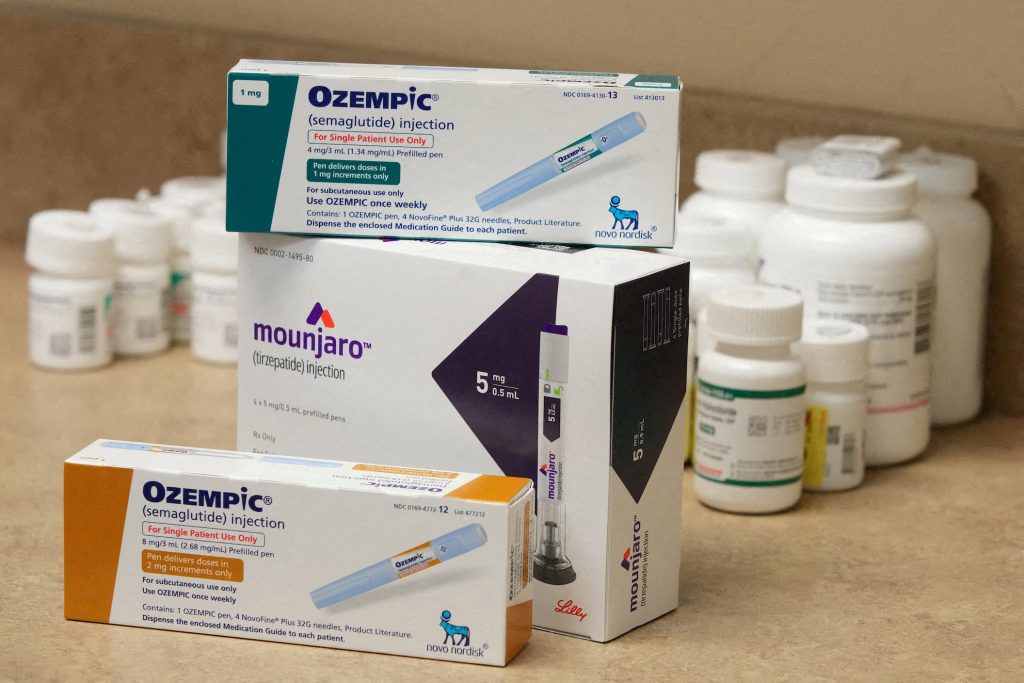Glucagon-like peptide-1 receptor agonists (GLP-1 RAs) are primarily used to manage type 2 diabetes and/or obesity. These medications mimic the natural GLP-1 hormone, which is secreted by the intestines in response to food intake.
How GLP-1 Receptor Agonists Work
GLP-1 hormone work by…
- Suppressing your appetite.
- Slowing gastric emptying.
- Stimulating insulin release and inhibiting glucagon release.
Taking a GLP-1 receptor agonist “supplements” your natural GLP-1 levels to enhance the above-mentioned effects in the body.

Types of GLP-1 Drugs
GLP-1 drugs come in various forms. Here’s a look at the available options in the market right now:
Short-Acting Injectable GLP-1 Drugs
These medications are administered 1-2x daily via subcutaneous injection. This method allows the drug to be absorbed gradually into the bloodstream.
Examples include:
- Exenatide (twice daily)
- Liraglutide (daily)
- Lixisenatide (daily)
Long-Acting Injectable GLP-1 Drugs
Long-acting formulations are administered 1x a week so they’re more convenient.
Examples include:
- Dulaglutide (weekly)
- Exenatide extended-release (weekly)
- Semaglutide (weekly)
Oral GLP-1 Drug
Semaglutide is also available as an oral option. Oral GLP-1s are absorbed through the gastrointestinal tract and into the bloodstream.
The Benefits of GLP-1 Drugs
Approximately 1 in 10 Americans have diabetes, with the majority of them having type 2 diabetes. This condition can lead to serious health issues such as heart disease, vision loss, and kidney disease if not managed properly.
GLP-1 drugs help manage blood sugar levels by:
- Increasing insulin production
- Reducing glucagon secretion
They also aid in weight loss by curbing appetite and increasing feelings of fullness.
GLP-1 Mechanism of Action
GLP-1 is naturally produced in the gut in response to carbohydrate intake. It binds to receptors in various tissues, including the pancreas, to stimulate insulin production and lower blood sugar levels.
GLP-1 drugs mimic this hormone in three primary ways:
- Stimulating insulin release after meals
- Inhibiting glucagon release
- Slowing gastric emptying to prolong satiety
These actions help maintain lower blood sugar levels and support weight loss.
Potential Side Effects of GLP-1s
Common side effects of taking GLP-1 medications include:
- Diarrhea, vomiting and nausea
- Mildly increased heart rate
- Dizziness
- Headaches
- Infections
- Injection-site reactions (itchiness, redness)
Most GLP-1 drugs have a low risk of hypoglycemia (low blood sugar). However, people with certain conditions or histories, such as medullary thyroid cancer, multiple endocrine neoplasias, acute pancreatitis, or severe gastrointestinal diseases, should avoid these medications.
Which Type of GLP-1 is Best for Me?
There are various GLP-1 receptor agonists available and they vary in formulations and benefits. The best choice for you depends on your individual needs and the balance of benefits versus risks.
FDA-Approved GLP-1 Receptor Agonists
Current GLP-1 receptor agonists approved by the FDA include:
- Semaglutide (Rybelsus, Ozempic, Wegovy)
- Exenatide (Bydureon BCise, Byetta)
- Lixisenatide (Adlyxin)
- Lixisenatide/insulin glargine (Soliqua)
- Liraglutide (Saxenda, Victoza)
- Liraglutide/insulin degludec (Xultophy)
- Dulaglutide (Trulicity)
Choosing the Right GLP-1 Receptor Agonist
The choice of GLP-1 receptor agonist depends on various factors, including:
Effectiveness for Blood Sugar Control
All FDA-approved GLP-1 receptor agonists are effective for blood sugar regulation. Recent research suggests that tirzepatide may be the most effective for controlling blood sugar.
Effectiveness for Weight Loss
Semaglutide has shown superior performance for weight loss, and a more recent data indicates that the semaglutide/cagrilintide combination (CagriSema) could be even more effective.
What to Expect When Taking GLP-1 RAs
GLP-1 receptor agonists usually come in a dosing pen with a fine needle for self-injection. If you’re uncomfortable with self-injection, your healthcare provider can assist you.
The onset of effectiveness varies. Some GLP-1 receptor agonists are fast-acting and used daily. Long-acting ones might take weeks to reach a therapeutic level. If you stop taking a GLP-1 receptor agonist, you may experience rebound effects such as increased hunger, weight gain, and elevated blood sugar.
Treatment for diabetes and obesity is often considered lifelong. In one clinical trial for semaglutide, participants regained up to two-thirds of the weight they had lost one year after stopping the medication.